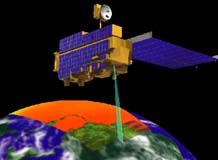| . |  |
. |
 Teamwork Reduces Orbital Terra
Teamwork Reduces Orbital TerraGreenbelt - January 24, 2000 - After more than four weeks of the Terra spacecraft on-orbit, both the spacecraft and instruments continue to perform extremely well. "All of the on-board instruments are continuing their outgas period," said Kevin Grady, Terra Project Manager at NASA's Goddard Space Flight Center, Greenbelt, Md. "The spacecraft is presently flying under the control of the spacecraft controls computer in its normal mission control mode, with the high gain antenna being used for both S and Ku band dumps." X-band dumps are also being scheduled periodically, with analysis of the tape of the first X-band contact, recorded last week, indicating that it contained good recoverable data. Earlier in the week, testing of the high gain antenna motor drive electronics was completed, confirming that there are no parts stress issues associated with using the electronics in the South Atlantic Anomaly. Further, there are no operational constraints on the use of the high gain antenna through the South Atlantic Anomaly during Terra's science mission. On Monday January 10, Terra completed its first maneuver to raise the orbit. This was a brief 11 second burn to establish the functionality of the thruster control modes. At the time, controllers believed they had validated the orbit adjust control capability of Terra. The following day, while attempting the first of four large maneuvers, the Terra flight computer aborted the maneuver 66 seconds into the burn. The flight software shutdown the maneuver when the computer detected a small rolling motion on the spacecraft. The spacecraft was safe at all times and no telemetry data was lost. The Team is in the process of analyzing the telemetry and developing a new burn sequence to get Terra to its final orbit at the earliest possible date. Controls engineers have identified a number of factors which are potential causes for the roll motion, and are in the process of developing a plan for the corrective action and new orbit ascent sequence. Terra was launched from Vandenberg Air Force Base, Calif., on Dec. 18, 1999, at 1:57 p.m. EST, and is the "flagship" to the Earth Observing System series of satellites, part of a precedent setting program designed to provide daily information on the health of the Planet. The primary objective of the Terra Mission is to simultaneously will study clouds, water vapor, small particles in the atmosphere (called "aerosol" particles), trace gases, land surface and oceanic properties, as well as the interaction between them and their effect on the Earth's energy budget and climate.
|
| |||||||||
| The content herein, unless otherwise known to be public domain, are Copyright 1995-2016 - Space Media Network. All websites are published in Australia and are solely subject to Australian law and governed by Fair Use principals for news reporting and research purposes. AFP, UPI and IANS news wire stories are copyright Agence France-Presse, United Press International and Indo-Asia News Service. ESA news reports are copyright European Space Agency. All NASA sourced material is public domain. Additional copyrights may apply in whole or part to other bona fide parties. Advertising does not imply endorsement, agreement or approval of any opinions, statements or information provided by Space Media Network on any Web page published or hosted by Space Media Network. Privacy Statement All images and articles appearing on Space Media Network have been edited or digitally altered in some way. Any requests to remove copyright material will be acted upon in a timely and appropriate manner. Any attempt to extort money from Space Media Network will be ignored and reported to Australian Law Enforcement Agencies as a potential case of financial fraud involving the use of a telephonic carriage device or postal service. |